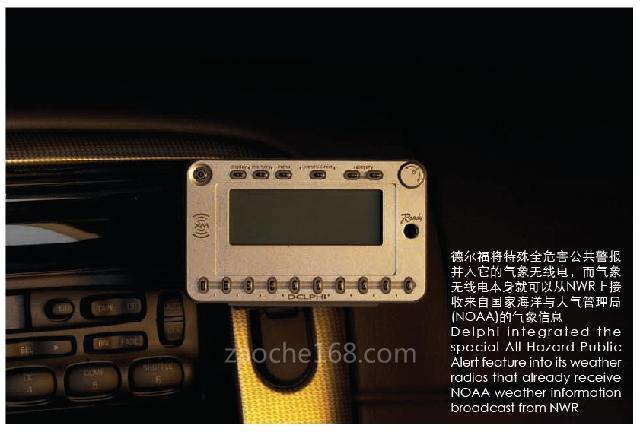2025年10月31日
TE2025年10月30日
罗克韦尔2025年10月24日
采埃孚2025年10月24日
兆易创新2025年10月24日
欣旺达2025年10月27日
魏德米勒
2025年10月22日
倍福
2025年10月16日
罗克韦尔
2025年10月16日
明珞装备
2025年10月11日
EMAG
2025年10月31日
海克斯康
2025年10月24日
Melexis
2025年10月24日
倍加福
2025年10月23日
科尔摩根
2025年10月23日
海康机器人
At the International Consumer Electronics Show held in the US city of Las Vegas, Delphi showcased emerging technologies including a mobile radio product. The All-Hazard Public Alert radio is a patented technology and is integrated into a vehicle head unit. The unit takes weather radio functionality to a new level by helping to keep listeners connected when emergencies occur.
In addition to providing drivers with warnings of essential NOAA (National Oceanic and Atmospheric Administration) national weather service announcements, the radio can also receive non-weather related emergency announcements such as warnings for terrorist threats, amber alerts and other localised emergencies.
“An early warning system in a crisis situation can mean the difference between success and failure, or even life and death,” says Kenneth Erickson, product line lead executive, Delphi. “The Delphi All-Hazard Public Alert radio can help get critical information out when and where crisis messaging is needed.”

Effective coverage
The All-Hazard Public Alert radio system can broadcast warnings for both severe weather and non-weather emergencies using the NOAA All-Hazards Weather Radio (NWR) network, which includes 985 stations and covers roughly 98 per cent of the US population. The all-hazard signal interrupts AM/FM, satellite radio or CDs when an emergency message needs to be broadcast. The emergency alert is sent by specific area message encoding (SAME) digital code technology on the weather broadcast system. The system provides users with county or parish codes that can be selected to ensure the alers are only issued in the geographical area where they are applicable.
“We believe that the All-Hazard Public Alert radio can increase the effectiveness of getting out emergency warnings,” says Mark Paese, NOAA director of operations and homeland security. “Many vehicle makers have already adopted weather band radio; the public alert feature is the next logical step up to increase the warning capability.”
Delphi integrated the special All Hazard Public Alert feature into its weather radios that already receive NOAA weather information broadcast from NWR. Using GPS signalling, Delphi’s proprietary NWR receiver knows which of the seven NWR frequencies to tune into. By using existing hardware, Delphi is able to produce the radio at a modest cost while still meeting all consumer electronics association (CEA) certification and technical standards.
“Since consumers are always interested in improving safety and staying informed it is no surprise that the feature scores as an item that they would purchase,” says Erickson.
Since beginning production in 1936, Delphi has manufactured more than 283 million radios, including 18 million satellite radio systems, and introduced an array of new technologies.
参考译文:
在美国拉斯维加斯举行的国际消费类电子产品展会上,德尔福展示了各种突破的技术,其中就包括了一款移动无线电产品。全危害公共报警无线电(All-Hazard Public Alert Radio)已经取得了专利并且归入控制单元。该单元将气象无线电的功能带上了一个新台阶,当紧急状况发生时它能帮助收听者及时接受到信息。
除了将基本的国家海洋与大气管理局(NOAA)的国家气象服务公告提供给驾驶者以外,该无线电还能够收到气象报告之外的一些紧急公告,例如恐怖袭击的警告,儿童诱拐和另一些所在地的紧急情况。
“在危机状况下的预警系统可能意味着成功和失败间的区别,甚至是生与死的区别。”德尔福的生产线首席执行官Kenneth Erickson谈到,“德尔福的全危害公共报警无线电可以在需要了解危机信息的时间和地点帮助给予危急信息。”

有效覆盖
全危害公告报警无线电系统可以利用国家海洋与大气管理局全危害公共气象无线电NWR网络来播送多种气象警示和非气象紧急情况。该系统包括了985个无线电站,覆盖了大约98%的美国人口。当有紧急信号需要播放时,全危害信号可以暂时打断调幅/调频,卫视无线电或者CD播放。在气象播报系统中采用了特定区域信息编码数字编码技术来进行紧急警报。该系统用郡或者教区的编码为使用者提供信息,从而保证了警报只在该编码适用的地区发挥作用。
“我们相信全危害公告警报无线电可以提高脱离紧急情况警告的效果。”国家海洋与大气管理局国土安全与业务部主管Mark Paese谈到,“很多汽车制造商已经采用了气象频段收音机。”
德尔福将特殊全危害公共警报并入它的气象无线电,气象无线电本身就可以从NWR上接受来自国家海洋与大气管理局的气象信息。采用了GPS信号后,德尔福的NWR接收器可以判断选择调至七个NWR频率的其中一个。利用原有的硬件设备,德尔福能够用不多的成本来制造该无线电设备,但仍旧能够满足消费性电子产品协会所有的认证和技术标准。Erickson说:“既然消费者对于提高安全性和保持信息畅通总是很感兴趣,那么他们愿意掏钱购买这套体统也就不足为奇了。”
自从1936年生产产品以来,德尔福已经生产了超过2亿8300万套的无线电,包括1800万卫星无线电系统,提出了一大批的新技术。